Monthly Archives: October 2013
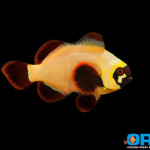
ORA Introduces the Gold Nugget Clownfish to market
The Gold Nugget maroon clownfish from ORA was first seen at Aquarama 2013 in Singapore. Now the production of this strain of clownfish has reached levels that allows ORA to release them on the market and they are now available to all ORA customers. Talk to your local reef store and ask them to bring some in if you want one.
The Guld Nugget Clownfish is a further development of the Goldflak maroon clownfish that ORA released September 2012. They where not a intentionally developed strain but rather a byproduct from increased gold flake clownfish production. When ORA started to increase production of the goldflake clownfish they discovered unique fry that were solid white and resembles Platinum percula clownfish but that develops a golden hue as they matures.
When young these gold nugget clownfish has a mostly white body with red and varying shades of red and maroon on the fins as well as the face. Some gold nugget juveniles will feature white on their face or even an tear drop under their eye. (should we guess that we will see tear drop clowns in the future?). The juveniles turns gold as they mature. When this happens depends on a number of different factors such as diet, habitat and lighting. They may start to turn gold after only 4-6 months but in most cases it takes more than a year for them to turn gold.
The Gold Nugget clownfish features a behavior such as you would expect from a maroon goldfish. They are in other words rather hardy and can be aggressive.
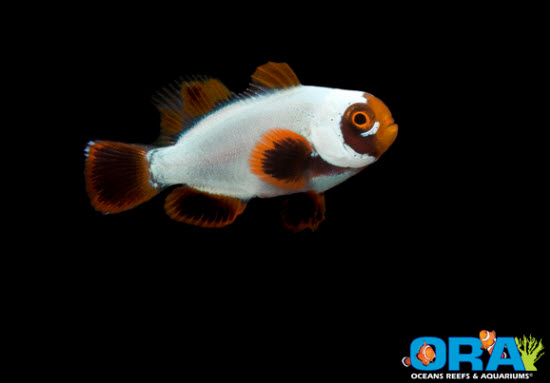
A juvenile gold nugget clown. Notice that white platinum hue in this juvenile fish. It takes from 4-6 month to more than a year for them to start to turn gold.
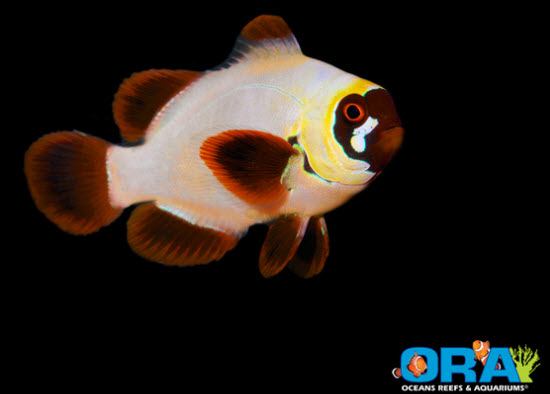
This specimen has just started to turn gold and you can start to see how it will look as an adult.
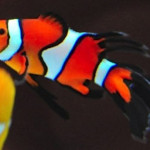
Introducing the Long Finned Clownfish
I guess we all knew that it was only a matter of time until we would see this, a long finned Ocellaris Clownfish. The fish was found in a batch of fry at Sustainable Aquatics breeding facility where marine biologist Matthew Jolley thought it looked odd as a young fish and separated it from the others to prevent it from being beaten up or killer. It was being severely bullied and was injured. The parents had produced many thousands of fry but this is the first long finned fry that has been spotted.
The young long finned male has healed up and been paired with a wild caught larger female (to garantee genetic diversity) and they seem to have bonded well. They have started spawning and Sustainable Aquatics is expecting their first batch of fry any day.
It still needs to be seen whether or not the long finned ocellaris breed true but there is reason to be believe that he may and if this is the case it will likely not be long until we start seeing this long fined clownfish type in the stores.
The reason that it is likely that he breeds true is that the trait likely is dominant or partially dominant; most long fin mutations in fish are. If this is the case in the ocellaris clown fish than we can expected to see long finned versions of most color morphs as the trait get bred into existing lines.
Read Sustainable Aquatics facebook announcement here.
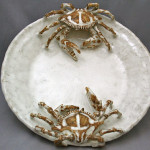
Ceramic Reef Art By Shayne Greco
This is not really aquarium related but it is kind of reef related and I thought it was rather neat. The ceramic art by Shayne Greco is good looking and made to be usable. I for one would love to have the octopus sink but would be afraid that it would break in shipping. The art is available in galleries around the nation and through his Etsy Shop.
Let us know what you think about this art by commenting below.
Thanks to advancedaquarist for bringing this to my attention.
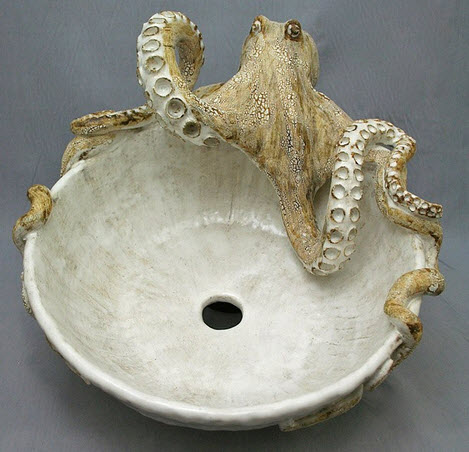
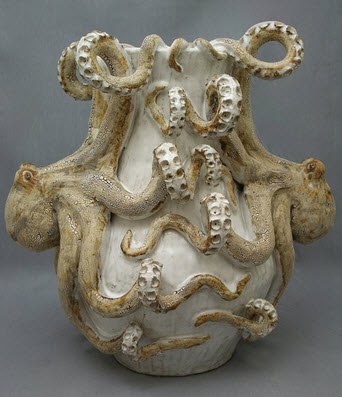
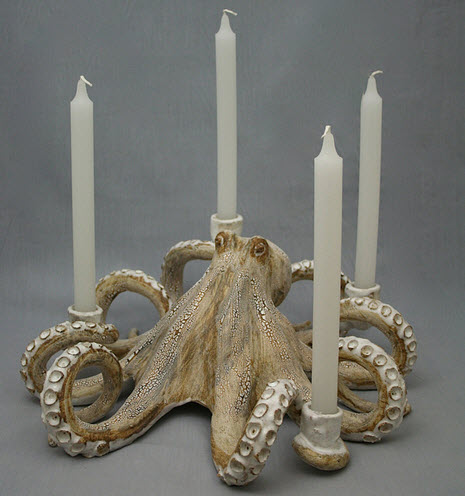
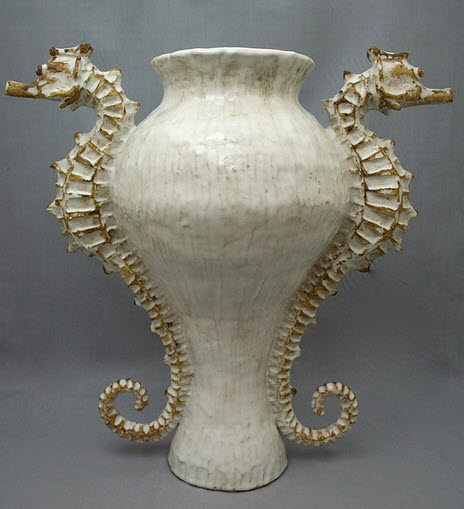


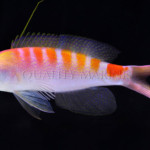
Unknown Anthias discovered in New Caledonia by fish collectors
Fish collectors in New Caledonia has found a species of Anthias previously unknown in the fish keeping hobby. The species has not been described scientifically and is thus without any scientific name. The collectors, working for marine fish wholesale importer Quality Marine, has dubbed the fish New Caledoina Sunrise Anthias as it is adorned with red-orange bars and hues of yellow and pink. Credit for first collecting this species goes to Antoine Teitelbaum, and credit for first seeing this species goes to Tony Nahacky.
“When first received by QM, we were unable to conclusively identify them as any of the known species,” Quality Marine explains in an official statement posted on their website. “Antoine and Tony reached out to a number of ichthyologists, some of whom have confirmed our suspicion that they are indeed a new species and are in the process of describing it for the scientific community.”
According to information provided by Quality Marine, the New Caledonia Sunrise Anthias is a deep water fish that forms large schools. Research indicates that the sex ratio within a school is 1:1. It is possible that the fish is endemic to New Caledonia. The New Caledonia Sunrise Anthia eats plankton just like other Anthias, and seems to chiefly feed on zooplankton and other meaty foods suspended in the currents.
Keeping The New Caledonia Sunrise Anthias in aquariums
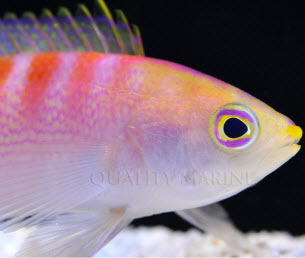
A cose up of the Caledonia Sunrise Anthias.
At Quality Marine, the collected New Caledonia Sunrise Anthias are currently being kept in two large schools. Dominant males and females can engage in some semi-violent behavior, but aside from this the school is peaceful.
“As a species, they seem to be less aggressive than many of the other Anthias this size. Because of our success in larger groups, they will likely be held like this in the future, and should be held in at least small groups (pairs, harems, etc) in the store display and home aquariums,” is the official advice provided by Quality Marine at this point.
As soon as the fish had acclimated, they started eating Nutramar OVA. After a day or so, they would also accept other meaty foods. They are now kept in on a diet of Nutramar OVA, enriched brine shrimp, Gamma mysis, krill, chopped prawn and other finely chopped meaty foods.
Probably a Pseudoanthias
Although the New Caledonia Sunrise Anthias has not be scientifically named yet, it can be tentatively placed in the genus Pseudoanthias. That would make it a close relative of species such as Sea Goldie (Pseudanthias squamipinnis), Bicolor Anthias (Bicolor anthias), Tiger Anthias ( Pseudanthias lori) and Two-spot Basslet (Pseudanthias bimaculatus).
The visual similarity between the New Caledonia Sunrise Anthias and other slender deep-water dwelling Pseudoanthias from the Pacific Ocean is easy to notice.
The New Caledonia Sunrise Anthias sports red vertical bars on the back, in a patter somewhat similar to the one displayed by Tiger Anthias ( Pseudanthias lori). The bars of the New Caledonia Sunrise Anthias are very wide and pronounced, and they reach halfway down the flank of the body. There is also a bright red saddle present at the base of the tail fin. Male specimens are normally more brilliantly colored than females, and males have a dorsal spine that proceeds far beyond the dorsal fin.
Buying New Caledonia Sunrise Anthias
Quality Marine will release the New Caledonia Sunrise Anthias on the aquarium market in the coming weeks. They do not sell directly to consumers, so fish keepers interested in keeping Sunrise Anthias need to contact marine fish stores and ask them to procure the fish for them.
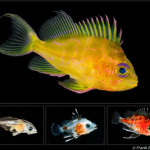
Hawaiian deepwater fish successfully reared from wild collected eggs
Odontanthias fuscipinnis, commonly known as Yellow Fin Anthias, is a much sought after deepwater fish endemic to the waters of Hawaii. It’s highly coveted by reef aquarists due to its striking coloration, and can cost $1 000 or more to procure.
In the future, captive raised Yellow Fin Anthias may start showing up in the trade, because marine fish expert Frank Baensch has now managed to rear wild collected eggs into nearly full grown fish in captivity. As far as we know, he is the first person to ever accomplish this feat. The species was reared as part of the Hawaii Larval Fish Project.
In December 2012, Baensch collected a small number of eggs from surface waters off Oahu and brought them to RCT Hawaii. When the eggs hatched, bright red larvae emerged.
“Features of the larvae include an elongated second dorsal spine and pelvic fin rays; pronounced head spination; brown pigment spots below the dorsal fin; and red pigment blotches on the body,” says the official blog of the Hawaii Larval Fish Project.
The larvae was kept in a 50 liter tank with multiple species and were fed wild caught Copepod nauplii plankton. According to Baensch, the larvae were robust in their 50 liter mixed species environment – good news for other marine aquarists interested in breeding or raising Yellow Fin Anthias.
As they matured over the course of 80 days, the larvae developed into small juvenile fish, lost their bright redness and started displaying the yellow coloration typical for adult Yellow Fin Anthias.
Odontanthias
Odontanthias is a genus of fishes in the subfamily Anthiinae in the family Serranidae. They inhabit rocky reefs and are found in deep waters; typically below 100 meters. A vast majority of the known species live in the Indo-Pacific, but Odontanthias hensleyi is native to the Caribbean
Just like other members of the subfamily Anthiinae, Odontanthias are planktivores with a peaceful temperament. They form schools in the wild and can be seen in large numbers above the reef while feeding. Since they are small to medium-sized, strikingly colored, non-aggressive and do not eat other fish, they have become much sought after by marine fish keepers.
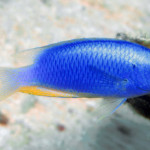
Pomacentrus micronesicus – new damselfish species from Micronesia
Picture above Courtesy of Jeanette Johnson. Liu et al. Zoological Studies 2013 52:6 doi:10.1186/1810-522X-52-6
Say hello to Pomacentrus micronesicus, a newly described species of blue damselfish! It has been given the name Pomacentrus micronesicus since is was found in Micronesia.
The new species was identified by Shang-Yin Vanson Liu (National Taiwan University), Hsuan-Ching Hans Ho (University of California) and Chang-Feng Dai (National Dong Hwa University). The full report “A new species of Pomacentrus (Actinopterygii: Pomacentridae) from Micronesia, with comments on its phylogenetic relationships” has been published by Zoological Studies and can be found here.
Cryptic species
There are plenty of known species of blue damselfish already, and now the Micronesian damselfish Pomacentrus micronesicus has been added to the mix. It looks very similar to several other species of blue damselfish, but the presence of only a light yellow coloration on the ventral fins and tail can help us a bit when it comes to distinguishing the Micronesian damselfish from other similar species of blue damselfish. There are also a few other things to look for, which you will find more information about further down on this page.
Marine organisms that look extremely similar but are actually genetically distinct are known as cryptic species. Thanks to new techniques for DNA sequencing, it has become possible for researchers to test if two similarly looking specimens are genetically distinct or not. This is what Vanson Liu, Hans Ho and Dai did to the fish they collected off the cost of the Marshall Islands, and this is how they were able to confirm that they had encountered a new species of damselfish.
Where does this species live?
The 21 specimens of Pomacentrus micronesicus collected for the study lived around the Marshall Islands in Micronesia, in the western Pacific Ocean.
The holotype was found near the Kwajalein Atoll (9°11′2.87″N, 167°25′4.88″E), at a dept of 5-10 meters. It was hand netted by Scott Johnson on August 2, 2009.
What does a Micronesian damselfish like?
No specimens longer than 30 mm has been found so far. Pomacentrus micronesicus is metallic blue both anteriorly and dorsally, with a light yellow ventral portion. The dorsal fin has the same metallic blue color, while the pectoral fin (including the soft ray of the pectoral fin) is of a light blue shade. The pelvic fin is light blue to yellow, with a blue anterior margin. The anal fin is also light blue to yellow, and has a blue margin, but is in addition to this adorned with small blue spots. The caudal fin is light blue to yellowish, with a few blue spots on the anterior portion.
Pomacentrus micronesicus has a deeply forked caudal fin with a relatively long filamentous upper lobe. The body is ovate and slightly elongated. The mouth is terminal, small and oblique and forms an angle of about 40° to 60° to the horizontal axis of the head and body.
How can I distinguish between Pomacentrus micronesicus and Pomacentrus colestis?
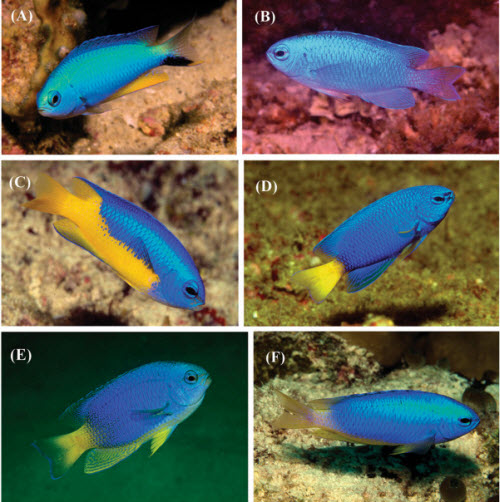
Photographs of the P. coelestis complex. (A) P. alleni, Weh Island, Sumatra, Indonesia. (B)P. coelestis, Nusa Kode, Komodo Islands, Indonesia. (C)P. auriventris, Raja Ampat Islands, Indonesia. (D)P. similis, Mergui Archipelago, Myanmar. (E)P. caeruleus, Andavadoaka, southwestern Madagascar. (F)P. micronesicus sp. nov., Chuuk, Federated States of Micronesia. Courtesy of GR Allen.
Liu et al. Zoological Studies 2013 52:6 doi:10.1186/1810-522X-52-6
P. micronesicus and P. colestis looks very similar to each other, but there are a few differences that can be useful for the reef aquarium keeper.
- Pomacentrus micronesicus tend to have a lower body depth than Pomacentrus colestis.
- Pomacentrus micronesicus usually has 15 rays on the anal fin while Pomacentrus colestis usually has just 14 rays.
- Pomacentrus micronesicus has 15 or 16 rakers on the lower limb of the first gill arch. Pomacentrus colestis has 13-14 rakers.
- Pomacentrus micronesicus has a total of 20-23 gill rakers on the first gill arch. Pomacentrus colestis only has 18-21 rakers.
- Look at the caudal fin of your fish. Pomacentrus micronesicus usually has a filamentous upper lobe that is deeply concave. Although this can occur in Pomacentrus colestis too, it is much less common.
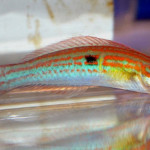
Minute wrasse – Minilabrus striatus – new species available at ACI Aquaculture
The Minute wrasse is a small colorful wrasse that can reach 2.5 inches / 6 cm in length. It is the only species in its genus and its small size makes it a perfect fit for small marine aquariums and marine aquarium with sensitive invertebrates in them. The species is reef safe but can eat small invertebrates. It should not be kept with larger fish. The Minute wrasse is a schooling species and should as such never be kept alone. It originates from the south and central parts of the red sea.
The minute wrasse that is now available at ACI Aquaculture is very rare in the aquarium trade and this might be the first time it has been imported to the USA. This is a shame since it is a stunning little gem that would make a wonderful addition to our aquariums.
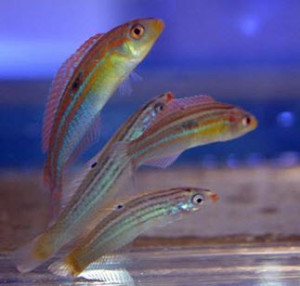 The species is according to my own observations plentiful in the wild in the red sea and the population should support a more widespread harvesting for the aquarium trade if it were to become a more popular species. In the red sea it lives in shallow waters, usually less than 36 ft / 12 meters deep. They are usually found in large groups at reef slopes. They are prominently found on the outher reef slopes but can from my observations be found anywhere on the reef where there is a drop of point. They are usually especially plentiful near caves at the outer reef slopes.
The species is according to my own observations plentiful in the wild in the red sea and the population should support a more widespread harvesting for the aquarium trade if it were to become a more popular species. In the red sea it lives in shallow waters, usually less than 36 ft / 12 meters deep. They are usually found in large groups at reef slopes. They are prominently found on the outher reef slopes but can from my observations be found anywhere on the reef where there is a drop of point. They are usually especially plentiful near caves at the outer reef slopes.
This species is as earlier mention best kept in groups but due to the limited numbers that have been collected and brought to the USA at this time it will be virtually impossible and cost prohibitive to to get a whole group. We would despite this like to recommend that anyone who is interested in this fish get at least 2 or 3. You will enjoy them a lot more and it also raises the possibility of breeding this species. Captive breeding on this species is highly desirable since it could make an excellent addition to our hobby.
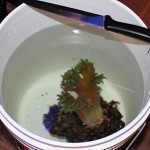
How to Frag Leather Corals
A good friend and fellow hobbyist asked me for a frag from one of my corals that he has really liked for a while now. As I was getting the frag for him, I thought I would take the time to show how I prefer to frag leather corals.This is not the only way to frag a coral, but it is the way that I find the easiest for both me and the coral.
Step – 1 Plan the frag
By this I mean you should decide what part of the leather you want to frag. In this instance, there is a small growth near the base of the blue mushrooms coral on the left hand side (as pictured below). I could have chosen almost any part of this leather to frag and it really would not have mattered too much, but that small growth just seamed it would be easier to frag.
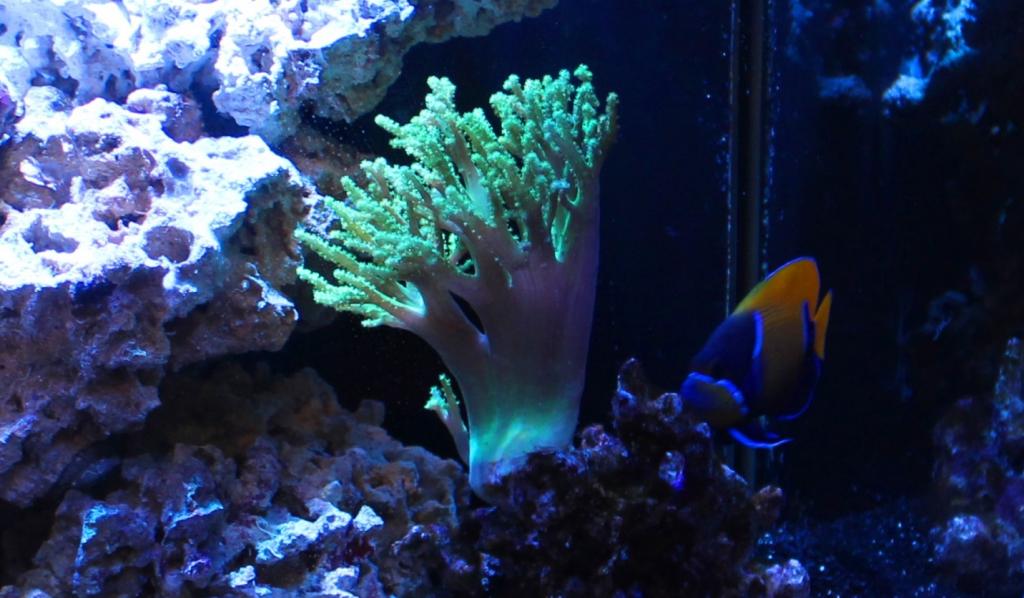
Step Two – Remove and Frag the leather
It is always best if you can remove the leather from the aquarium when you frag it. In this case I had removed the leather and the rock it was sitting on and placed it in a 5 gallon pale of tank water.There are two reasons for doing this. The first is that leathers can release toxins when being fragged, and the second is that you can add a coral treatment to the container to help the coral heal faster.Many others have successfully fragged leathers while still in the display tank.I have always been able to remove mine for fragging so I have always done that.
Step three – Frag it
This is simply cutting a part of the coral off from the rest of the coral. Make sure you use a very sharp razor or butcher’s knife and cut the peace off in one smooth and gentle motion.Remove the frag to a second container of water and leave the leather in the current container. Add a good quality coral treatment to both containers to help the corals heal the damaged areas. Once the main coral has had about 10 minutes in the coral treatment, you can replace it to your main display tank. I would also suggest having fresh carbon running on your set-up to remove any toxins the leather might release.
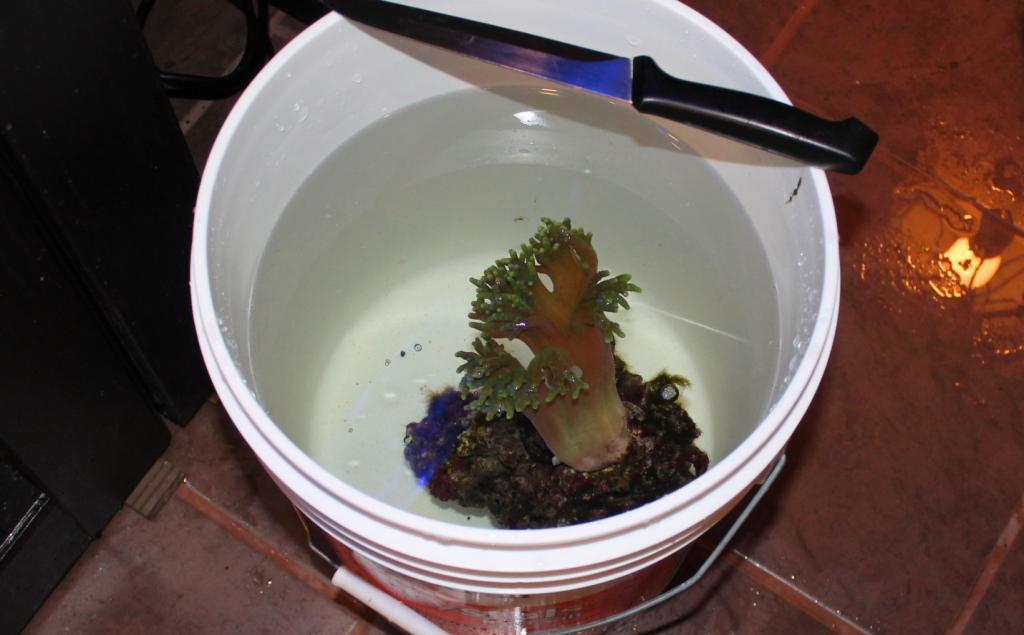
Step four – Attach the frag
In my experience, you have to let leathers naturally attach themselves to something.Every time I have tried an approach that involved glues or any other type of method, I found the leather will just produce extra slime coating and become detached within a day or two. I have the best success by using a rubber band to gently hold the frag to a frag plug or piece of rock. You want just enough pressure to hold the frag in place, any more and you could cause the frag to divide into two smaller pieces and both becoming detached.
You don’t have to worry about attaching the frag so it sits up-right as it will grow up-wards towards the light in no time at all.
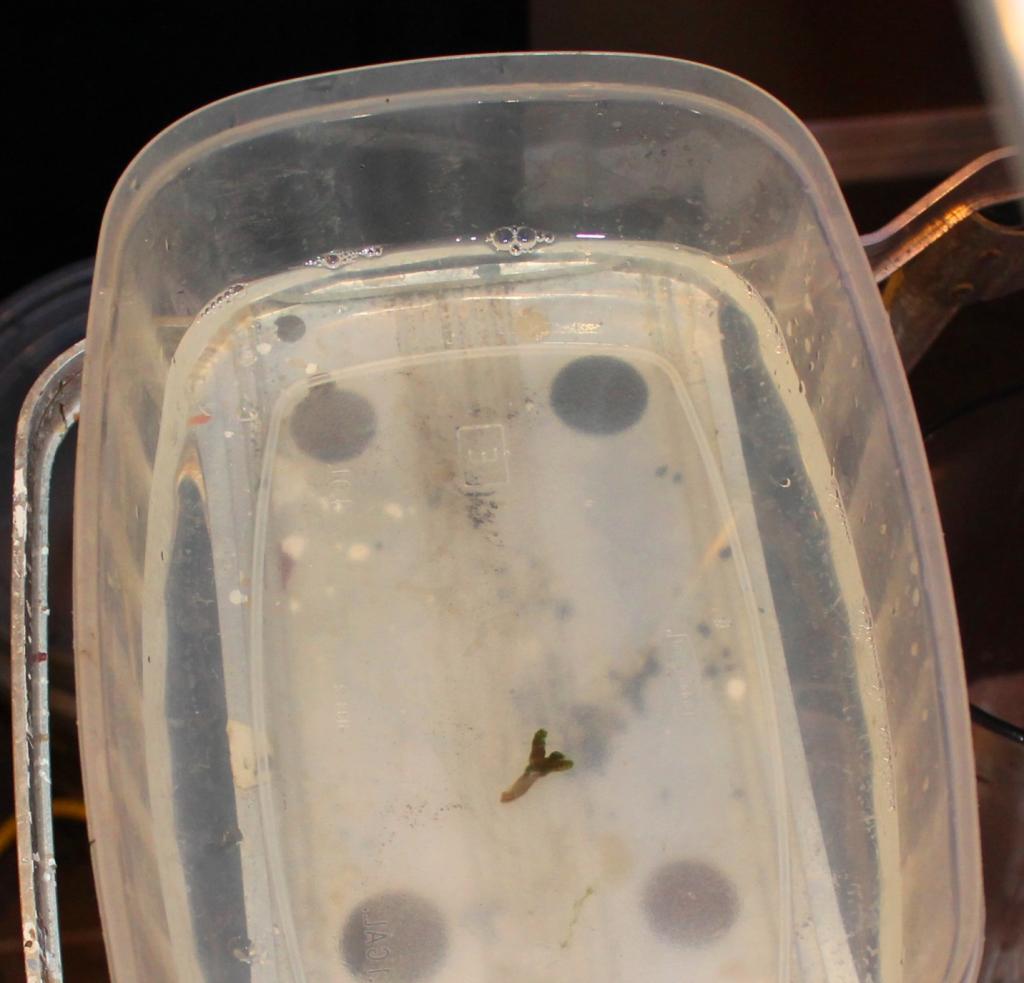
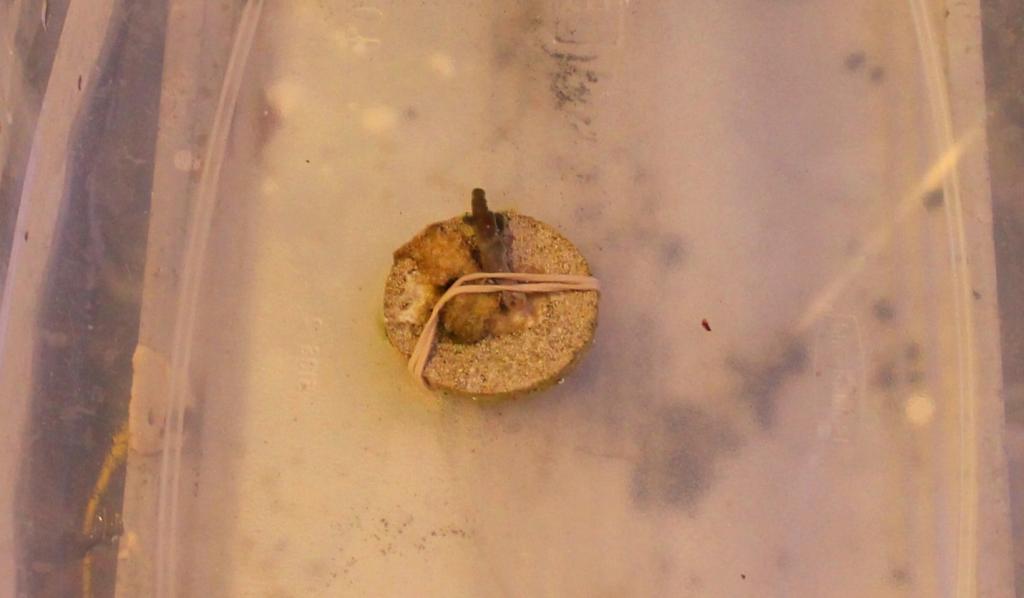
Step 5 – Return the frag
I always like returning the frag to the display tank as soon as it had about 10 minutes in the other container with a coral treatment. I will place the frag in a lower area of the aquarium with low flow to help the leather attach to the frag plug. In my experience, it takes about two to three weeks for the frag to attach to the plug assuming it is not getting stressed by crabs (or other critters) and it’s lighting and water quality needs are being met.
The below picture of the frag was taken after one day after being fragged
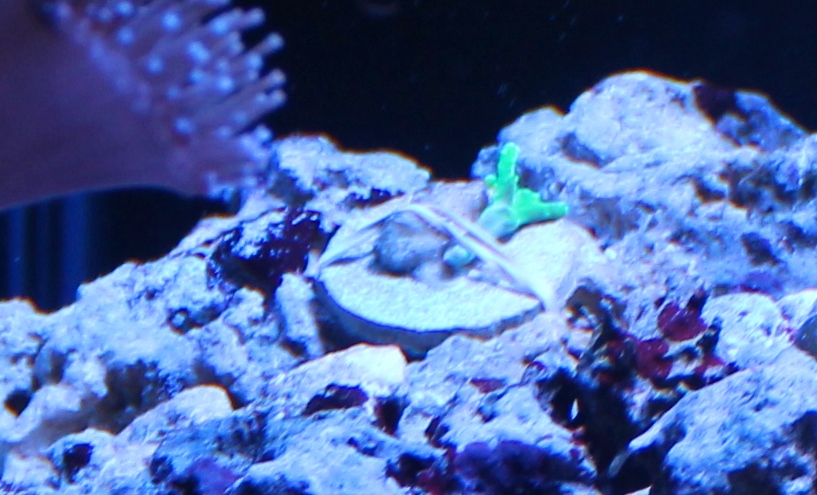
The below was taken four days after being fragged. You can see the leather is starting to turn up-wards towards the light and is also starting to extend its polyps.
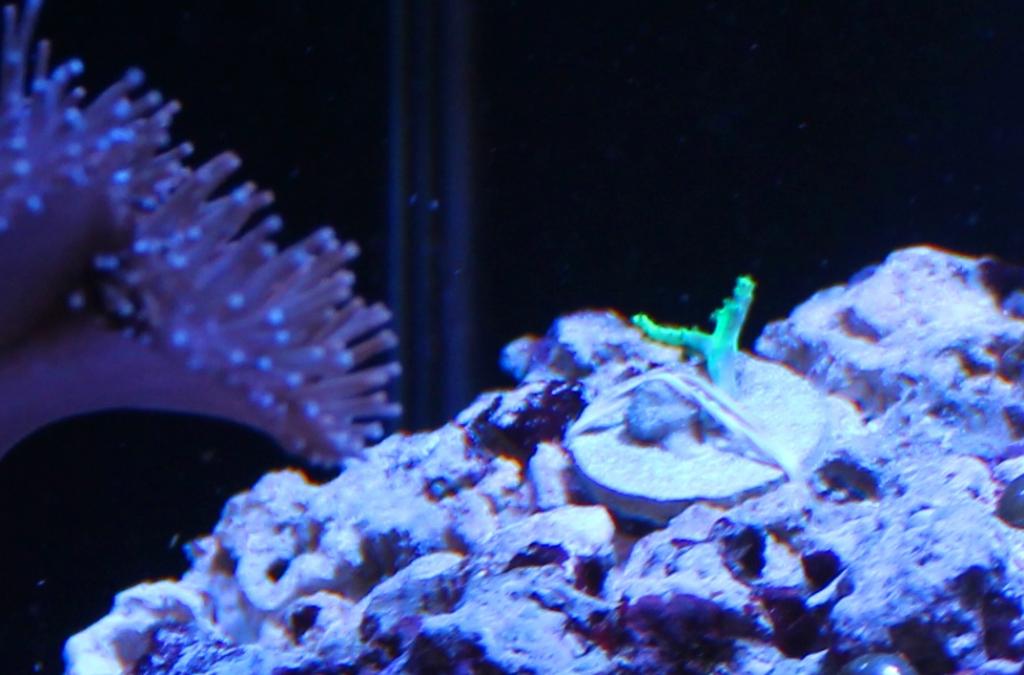
The below picture was taken 9 days after being fragged. The frag has already started to grow up-wards towards the light and looks like it is very close to becoming attached to the coral plug/
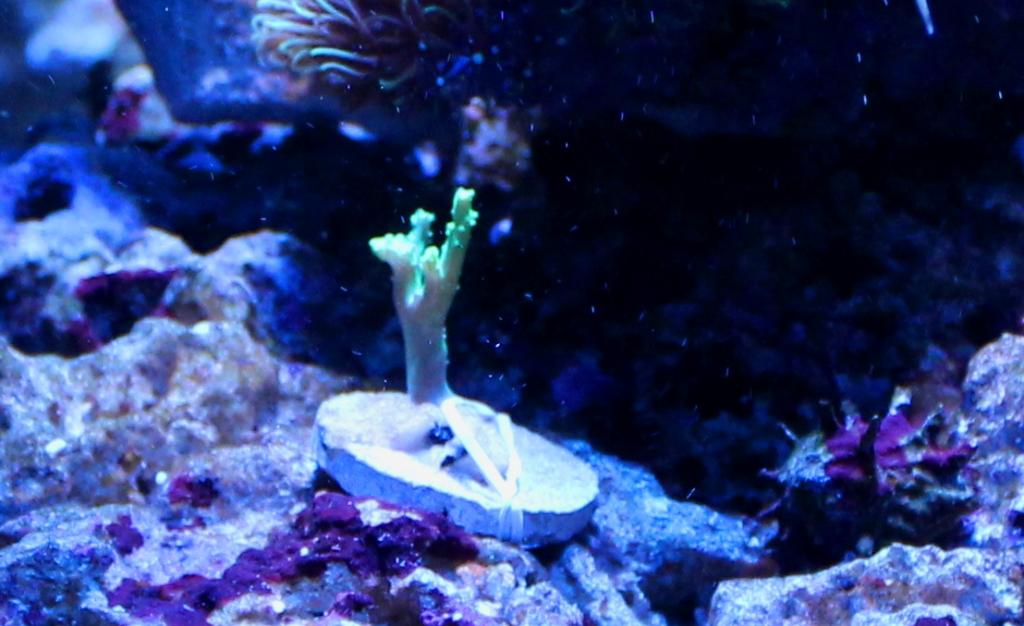
The next day after being fragged, the main leather has fully bounced back recovering from the process and looks to be in pretty good shape.
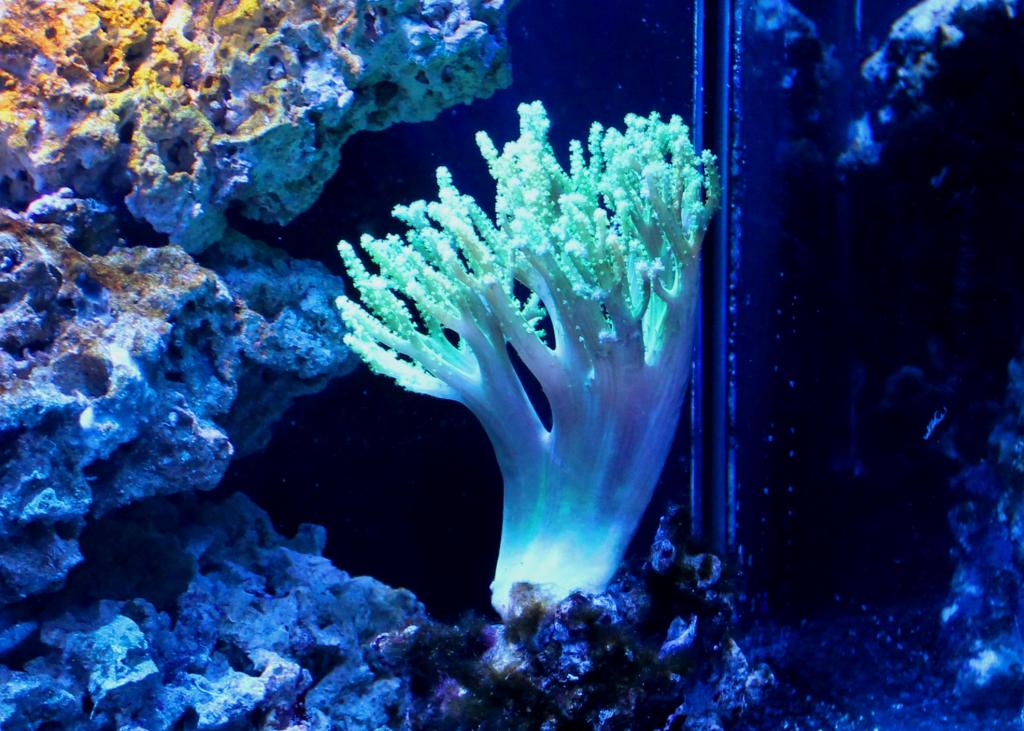

Tip of the Week #2
Beware of forums !!!
While forums are typically a great source of first hand knowledge, they can also be a pain in the backside for two different reasons.
When first starting and setting up your marine aquarium, your experience is limited. Even when you research more than enough, you still can make a mistake here and their when you are new to the hobby. Most of the time this is not a bad thing as there will be no permanent harm to your aquarium inhabitants and you will still be enjoying your aquarium in ignorant bliss, just like I had started started out in the hobby. However, if you unknowingly make a mistake to go to a forum to explain your situation and ask for advice, you will likely get a dozen or so people pointing out all of your mistakes. This can make it real easy to feel bad about yourself and limit your enjoyment you will get from your aquarium. Just keep in mind that almost all problems you will ever run into, can be corrected by applying a few basic and simple concepts. This hobby is not a “Black Art”.
Another reason for this warning is some hobbyist who have many decades of experience can forget they are talking to a newer or lessor experience hobbyist at times. This can make you feel like someone just explained to you how to build a watch when you only asked what time it was. Don’t get down on yourself when this happens, and it will happen. It can be easy to feel like you don’t know what you are doing when a fellow hobbyist tries to sum up his/her many many years of experience into a few paragraphs, just do your best to learn from the information. Once again, stick to the basics doing those well, and most every thing else will fall into place.
Also, I thought I would share the below links as I found them very interesting and I hope you will as well
http://blog.aquanerd.com/2013/05/diablo-dc3500-controllable-pump.html
http://blog.aquanerd.com/2013/08/vertex-aquaristik-sump.html
http://blog.aquanerd.com/2013/09/picture-of-the-week-mccoskers-flasher-wrasse-paracheilinus-mccoskeri.html